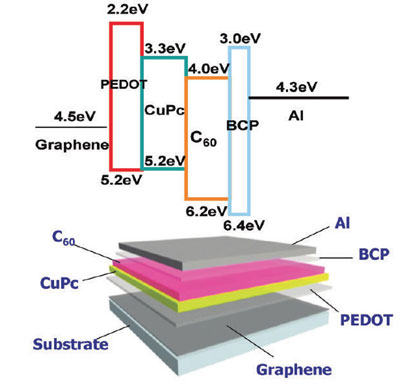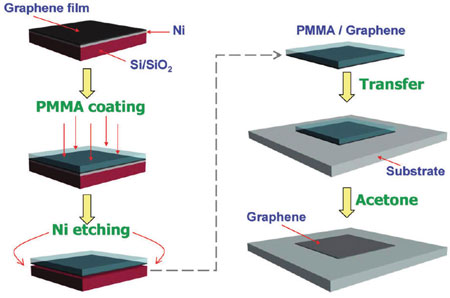| Posted: Oct 10, 2013 | |
Nanotechnology for solar cell applications - graphene-based materials |
|
| (Nanowerk Spotlight) Graphene-based nanomaterials have many promising applications in energy-related areas. In particular, there are four major energy-related areas where graphene will have an impact: solar cells, supercapacitors, lithium-ion batteries, and catalysis for fuel cells (read more: "Graphene-based nanotechnology in energy applications"). | |
| The extremely high electron mobility of graphene – under ideal conditions electrons move through it with roughly 100 times the mobility they have in silicon – combined with its superior strength and the fact that it is nearly transparent (2.3 % of light is absorbed; 97.7 % transmitted), make it an ideal candidate for photovoltaic applications. It could be a promising replacement material for indium tin oxide (ITO), the current standard material for transparent electrodes used for electrodes in LCD displays, solar cells, iPad and smart-phone touch screens, and organic light-emitting diode (OLED) displays for televisions and computer monitors. | |
| Just yesterday, for instance, there was a report ("Nanotechnology researchers make major leap towards graphene for solar cells") that shows that graphene retains its impressive set of properties when it is coated with a thin silicon film. These findings pave the way for entirely new possibilities to use in thin-film photovoltaics. | |
| A new review in Advanced Energy Materials ("Graphene-Based Materials for Solar Cell Applications") by a team of scientists from Nanyang Technological University, led by Prof. Hua Zhang, provides an overview of the recent research on graphene and its derivatives, with a particular focus on synthesis, properties, and applications in solar cells. | |
 |
|
| Schematic representation of the energy level alignment (top) and the construction of heterojunction organic solar cell fabricated with graphene as anodic electrode: graphene/PEDOT/CuPc/C60/BCP/Al. (©Wiley-VCH Verlag) | |
| With the unique properties, i.e., highly optical transparence, highly electrical conduction, and mechanical flexibility, graphene and its derivatives have been investigated extensively in the field of solar cells. | |
| The review looks in detail at some of the impressive results that have been reported where graphene was used as the electrodes, i.e.: | |
|
|
|
| as well as where graphene was used as the active layer, i.e.: | |
|
|
|
| Summing up their review, the authors conclude that it is promising that graphene, as the transparent electrode material, has exhibited superiority in that it is highly flexible, an abundant carbon source, and has high thermal/chemical stability, compared to the traditional ITO. In particular, the flexible transparent electrodes show applications not only in solar cells, but also in flexible touch screens, displays, printable electronics, flexible transistors, memories, etc. | |
 |
|
| Schematic illustration of the transfer process of CVD-graphene onto transparent substrate. (©Wiley-VCH Verlag) | |
| "In addition to working as transparent electrodes, graphene, graphene oxide (GO), and their derivatives show many other important applications that include being electron/hole transporters and serving as interfacial layers and Schottky junction layers in photovoltaics devices," write the authors. "Two-dimensional (2D) graphene oxide is capable of π-π stacking and hydrogen bonding. This makes it possible to use such a 2D scaffold as the template to self-assemble GO-based novel inorganic, organic, and inorganic-organic hybrids with multifunctionalities for applications in photovoltaics." | |
| "On the other hand, to enrich the application of graphene, processes on bandgap opening have always attracted the attention of scientists. To date, many methods have been investigated to engineer the band structure of graphene, including inducing a quantum confinement effect by reduction of graphene lateral size to form nanoribbons or nanomesh introducing foreign elements, and employing a strain effect from the substrate. We believe that graphene will play more and more important roles in solar cells and other fields, such as energy storage, optoelectronics, electrics and sensing, in the near future." | |
 By
Michael
Berger
– Michael is author of three books by the Royal Society of Chemistry:
Nano-Society: Pushing the Boundaries of Technology,
Nanotechnology: The Future is Tiny, and
Nanoengineering: The Skills and Tools Making Technology Invisible
Copyright ©
Nanowerk LLC
By
Michael
Berger
– Michael is author of three books by the Royal Society of Chemistry:
Nano-Society: Pushing the Boundaries of Technology,
Nanotechnology: The Future is Tiny, and
Nanoengineering: The Skills and Tools Making Technology Invisible
Copyright ©
Nanowerk LLC
|
|
|
Become a Spotlight guest author! Join our large and growing group of guest contributors. Have you just published a scientific paper or have other exciting developments to share with the nanotechnology community? Here is how to publish on nanowerk.com. |
|
